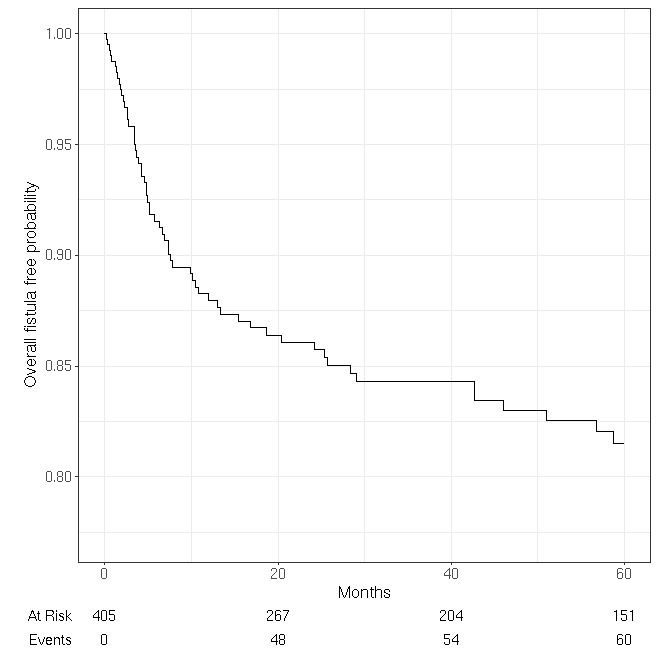Back to 2024 Abstracts
PERINEAL CROHN'S DISEASE RECURRENCE IS COMMON AFTER PROCTECTOMY FOR CROHN'S DISEASE - A MULTICENTRE STUDY
Ayman Khan
*, Imran Khan, Thomas Ward, Benjamin L. Cohen, Michael Valente, Stefan D. Holubar
Colorectal Surgery, Cleveland Clinic, Cleveland, OH
BACKGROUND
The TOpCLASS International Consortium recently described a paradigm shifting classification scheme for perianal Crohn's disease, based on the desired patient goals of care. Class 4 perineal fistulizing disease is a CD that persists after proctectomy, and there are limited data defining this entity. We sought to determine the rates of clinical perineal fistulizing disease after proctectomy and to secondarily define the risk factors for recurrence.
METHODS
Adult patients with CD who underwent perineal resection with proctectomy or proctocolectomy at three hospitals within our institution's health network between 2009 and 2021 were retrospectively reviewed. The exclusion criteria included a preoperative diagnosis of ulcerative colitis or indeterminate colitis, and patients who underwent restorative proctectomy. Extracted data included baseline demographic data, preoperative medical treatment for CD, proctectomy indication, clinical recurrence of perineal disease, and resolution of perineal disease.
RESULTS
405 patients with Crohn's disease were included including 190 patients who underwent proctectomy (46.9%) and 215 who underwent proctocolectomy (53.1%). The median age was 44 years (IQR 33-58) and 58.8% were female. Within 60 days prior to surgery 39.8% were exposed to biologic therapy, 29.1% to immunomodulators and 11.9% to corticosteroids. During a median follow up of 4 years (SD 3.8), stage IV perineal symptoms developed in 88 patients (21.7%), including recurrence of fistulizing perineal CD in 46 patients (11.4%), 5 patients with perineal-vaginal fistulas and 1 patient who developed adenocarcinoma. The median time to development of perineal disease after surgery was 6.5months (IQR 3-23months). Factors associated with perineal disease after surgery included younger age ( OR 1.39; p <0.01), female gender (OR 1.67; p = 0.04), smoker ( OR 2.5, p = 0.004) , higher BMI (OR 1.04, p = 0.045) and presence of perianal CD regardless of the indication for surgery (OR 2.95 p <0.001). There was resolution of perineal symptoms in 68 patients (77.3%). There were 79 patients who required an examination under anesthesia (EUA) for a perineal disease with the median number of EUA performed being 2 (range 1-21). No significant association was found between preoperative biologic therapy and development of perineal disease or resolution of recurrent perineal symptoms.
CONCLUSION
Perineal disease after proctectomy is common and frequently requires multiple surgical interventions. Most patients with perineal disease resolve their symptoms. Patients of younger age, female gender, current smokers, higher BMI and presence of perianal disease may benefit from more intensive postoperative review and consideration of early prophylactic CD medical management.

Back to 2024 Abstracts
